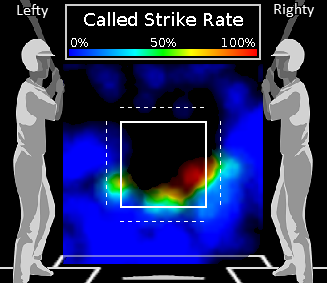Hell Boy's K Rate
 David Golebiewski |
David Golebiewski |  Tuesday, November 15, 2011 at 10:46AM
Tuesday, November 15, 2011 at 10:46AM
Tampa Bay Rays right-hander Jeremy Hellickson was named the AL Rookie of the Year yesterday. Hellickson had the traditional stats -- a winning 13-10 record and a 2.95 ERA -- that voters typically go for. But Hellickson's fielding-independent numbers weren't as shiny: his 4.44 FIP was actually well above the 4.00 average for starting pitchers in 2011.
While few doubt that the 24-year-old Hellickson has the skills to improve that FIP moving forward, there was a curious disconnect between the number of whiffs and the number of Ks that he recorded during his rookie season. Hellickson got hitters to miss 22 percent of the time that they swung, comfortably above the 19.8 percent average for starters. But, despite that solid miss rate, Hell Boy struck out just 14.9 percent of the batters that he faced, well below the 17.7 percent average for starters.
The cause of that low K% appears to be Hellickson's difficulty in getting called strikes in two-strike counts. In fact, no starting pitcher got a lower percentage of called strikes when the batter didn't have another one to spare:
Lowest Called Strike% on Pitches Taken in 2-Strike Counts, 2011
Check out Hellickson's called strike rate by location on taken two-strike pitches, and then the league average for righties. He didn't get many (any?) calls on pitches on the corners, and he very rarely got a called strike on a pitch thrown in the zone.
 Hellickson's called strike rate on taken 2-strike pitches
Hellickson's called strike rate on taken 2-strike pitches
Average called strike rate on taken 2-strike pitches for RHP
On taken two-strike pitches thrown in the strike zone, Hellickson's called strike rate was about 41 percent. The big league average was about 61 percent. Looks to me like Hellickson got squeezed pretty badly.
Why hasn't Hellickson gotten more called strikes on taken two-strike pitches? Two factors appear to be working against him. One, as you have have noticed from the list of low called strike pitchers above, is that handedness plays a role. Overall in 2011, right-handers had an 11 percent called strike rate on taken two-strike pitches, and left-handers had an 12.2 percent called strike rate in such situations.
Two, as you also may have noticed from the aforementioned list, changeups get fewer called strikes than other pitches in these situations. Hellickson adores his changeup, and he threw it over a third of the time in two-strike counts. Unfortunately, pitchers don't seem to get their due when they locate a two-strike changeup in the zone and the batter takes it. Look at the called strike rate on taken-two strike pitches located within the strike zone, by pitch type:
Fastball: 62.7 percent
Curveball: 62.6 percent
Slider: 57.8 percent
Changeup: 46 percent
It's hard to say what this means for Hellickson in 2012. On one hand, we'd expect him to strike out more batters because he does a pretty good job of getting hitters to miss when they swing. But, on the other, righties get fewer called strikes than lefties, and Hellickson's go-to pitch in two-strike counts doesn't garner called strikes at near the same rate as fastballs and breaking balls. Hellickson's changeup is a plus pitch -- hitters batted just .188 and slugged .308 against it -- but he might want to go to his fastball or curve more often when he wants to catch a batter looking with two strikes.

Reader Comments (1)
In our fashionable life, beautiful and lovely appearance are the pursuit of many girls. How can we miss rolex air king?